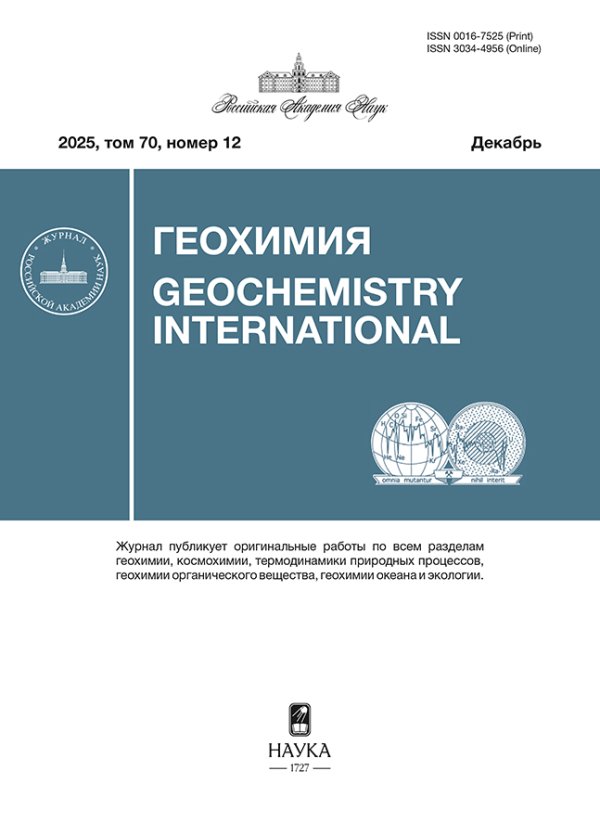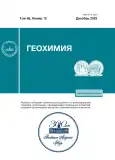Strontium and Neodymium Isotopic Signatures in Basalt Glasses of the Mid-Atlantic Ridge, 12°–31° N
- Authors: Tskhovrebova A.R.1, Shabykova V.V.1, Silantyev S.A.1, Buikin A.I.1
-
Affiliations:
- Vernadsky Institute of Geochemistry and Analytical Chemistry, Russian Academy of Sciences, 119991, Moscow, Russia
- Issue: Vol 68, No 12 (2023)
- Pages: 1241-1252
- Section: Articles
- URL: https://journals.rcsi.science/0016-7525/article/view/233637
- DOI: https://doi.org/10.31857/S0016752523120051
- EDN: https://elibrary.ru/LRTFOA
- ID: 233637
Cite item
Full Text
Abstract
This paper presents the new geochemical isotope (Sr–Nd system, H2O, Cl) data obtained for basalt glasses of the Mid-Atlantic Ridge (MAR) sampled from six areas of the MAR axial zone between 31° and 12° N. The data are consistent with the existing ideas about large-scale geochemical segmentation of the MAR. It is shown that samples from predominantly serpentinite segments have a narrower range of variations of strontium isotopic composition (87Sr/86Sr = 0.7027–0.7032) in comparison with samples collected from the areas where the crustal section is dominated by basalts (87Sr/86Sr = 0.7024–0.7041). The variation ranges of the neodymium isotopic composition in these two groups of samples are almost identical (εNd = +4.9 to +10.9 and +5.9 to +11.6 in serpentinite and basalt segments, respectively), although, in general, serpentinite segments have a slightly more enriched composition. The wide variations of the neodymium isotopic composition and increased contents of Cl, H2O, and U, as well as increased K2O/TiO2 and La/Sm ratios, in samples from serpentinites can most probably be related to the participation of different geochemically heterogeneous sources in the magmatism of the MAR axial zone. The influence of enriched plume-type matter cannot be excluded in some segments. The isotopic composition of noble gases may shed light on the subject.
Keywords
About the authors
A. R. Tskhovrebova
Vernadsky Institute of Geochemistry and Analytical Chemistry, Russian Academy of Sciences, 119991, Moscow, Russia
Email: tsann3@gmail.com
Россия, 119991, Москва, ул. Косыгина, 19
V. V. Shabykova
Vernadsky Institute of Geochemistry and Analytical Chemistry, Russian Academy of Sciences, 119991, Moscow, Russia
Email: tsann3@gmail.com
Россия, 119991, Москва, ул. Косыгина, 19
S. A. Silantyev
Vernadsky Institute of Geochemistry and Analytical Chemistry, Russian Academy of Sciences, 119991, Moscow, Russia
Email: tsann3@gmail.com
Россия, 119991, Москва, ул. Косыгина, 19
A. I. Buikin
Vernadsky Institute of Geochemistry and Analytical Chemistry, Russian Academy of Sciences, 119991, Moscow, Russia
Author for correspondence.
Email: tsann3@gmail.com
Россия, 119991, Москва, ул. Косыгина, 19
References
- Бортников Н.С., Силантьев С.А., Беа Ф., Монтеро П., Зингер Т.Ф., Сколотнев С.Г., Шарков Е.В. (2022) Разновозрастные цирконы и их изотопный состав (Hf, O) в породах осевой зоны Срединно-Атлантического хребта: свидетельства неоднократного плавления гетерогенной мантии и эпизодической аккреции океанической коры в зоне спрединга. Петрология. 30(1), 3-30.
- Костицын Ю.А. (2004) Sm-Nd и Lu-Hf изотопные системы Земли: отвечают ли они хондритам? Петрология. 12(5), 451-466.
- Костицын Ю.А. (2007) Взаимосвязь между химической и изотопной (Sr, Nd, Hf, Pb) гетерогенностью мантии. Геохимия. (12), 1267-1291.
- Kostitsyn Yu. A. (2007) Relationships between the Chemical and Isotopic (Sr, Nd, Hf, and Pb) Heterogeneity of the Mantle. Geochem. Int. 45(12), 1173
- Костицын Ю.А., Силантьев С.А., Аносова М.О., Шабыкова В.В., Сколотнев С.Г. (2018) Возраст плутонических пород разлома Вима (Центральная Атлантика) и природа их мантийных источников. Геохимия. (2), 1-23.
- Kostitsyn Yu.A., Silantyev S.A., Anosova M.O., Shabykova V.V., Skolotnev S.G. (2018) Age of Plutonic Rocks from the Vema Fracture Zone (Central Atlantic) and Nature of Their Mantle Sources. Geochem. Int. 56(2), 89-110.
- Крымский Р.Ш., Сущевская Н.М., Беляцкий Б.В., Мигдисова Н.А. (2009) Особенности изотопного состава осмия базальтовых стекол западного окончания юго-Западного Индийского хребта. ДАН. 428(1), 87-92.
- Портнягин М.В., Симакин С.Г., Соболев А.В. (2002) Фтор в примитивных магмах офиолитового комплекса Троодос (о. Кипр): методика определения и основные результаты. Геохимия. 7, 691-699.
- Portnyagin M.V., Simakin S.G., and Sobolev A.V. (2002) Fluorine in Primitive Magmas of the Troodos Ophiolite Complex, Cyprus: Analytical Methods and Main Results. Geochem. Int. 40(7), 625-632.
- Ревяко Н.М., Костицын Ю.А., Бычкова Я.В. (2012) Взаимодействие расплава основного состава с вмещающими породами при формировании расслоенного интрузива Кивакка, Северная Карелия. Петрология. 20(2), 115-135.
- Силантьев С.А. (1995) Метаморфизм в современных океанических бассейнах. Петрология. 1(4), 450-473.
- Силантьев С.А. (2003) Вариации геохимических и изотопных характеристик реститовых перидотитов вдоль простирания Срединно-Атлантического хребта как отражение природы мантийных источников магматизма. Петрология. 11(4), 339-362.
- Силантьев С.А., Данюшевский Л.В., Плечова А.А., Доссо Л., Базылев Б.А., Бельтенев В.Е. (2008) Геохимические и изотопные черты продуктов магматизма рифтовой долины САХ в районах 12°49′–17°23 с.ш. и 29°59′–33°41 с.ш.: свидетельство двух контрастных источников родительских расплавов. Петрология. 16(1), 38-65.
- Силантьев С.А., Бортников Н.С., Шатагин К.Н., Бычкова Я.В., Краснова Е.А., Бельтенев В.Е. (2015) Перидотит-базальтовая ассоциация САХ на 19°42′–19°59′ с.ш.: оценка условий петрогенезиса и баланса вещества при гидротермальном преобразовании океанической коры. Петрология. 23(1), 1-23.
- Силантьев С.А., Буйкин А.И., Цховребова А.Р., Шабыкова В.В., Бельтенев В.Е. (2023) Вариации состава закалочных стекол MORB Срединно-Атлантического хребта, 12°–31° с.ш.: отражение эволюции состава родительских расплавов и влияния гидротермального компонента. Петрология. 31(5), 4хх-4хх.
- Соболев А.В. (1996) Включения расплавов в минералах как источник принципиальной петрологической информации. Петрология. 4(3), 228-239.
- Шарков Е.В., Бортников Н.С., Богатиков О.А., Зингер Т.Ф., Бельтенев В.Е., Чистяков А.В. (2005) Третий слой океанической коры в осевой части Срединно-Атлантического хребта (полигон Сьерра-Леоне, 6° c.ш). Петрология. 13(6), 592-625.
- Bougault H., Dmitriev L., Schilling J.G., Sobolev A., Joron J.L., Needham H.D. (1988) Mantle heterogeneity from trace elements: MAR triple junction near 14° N. Earth Planet. Sci. Lett. 88, 27-36.
- Buikin A.I., Silantyev S.A., Verchovsky A.B. (2022) N–Ar–He–CO2 systematics combined with H2O, Cl, K abundances in MORB glasses demonstrate interaction of magmatic and hydrothermal systems: a case for MAR at 16°07′–17°11′ N. Geochem. Int. 60(11), 1068-1086.
- DePaolo D.J. (1980) Crustal growth and mantle evolution: inferences from models of element transport and Nd and Sr isotopes. Geochim. Cosmochim. Acta. 44, 1185-1196.
- DePaolo D.J. (1983) The mean life of continents: estimates of continental recycling rates from Nd and Hf isotopic data and implications for mantle structure. Geophys. Res. Lett. 10, 705-708.
- Dosso L., Hanan B.B., Bougolt H., Schilling, J.G., Joron J.L. (1991) Sr-Nd-Pb geochemical morphology between 10° and 17° on MidAtlantic Ridge: a new MORB isotope signature. Earth Planet. Sci. Lett. 6, 29-43.
- Fedotova A.A., Bibikova E.V., Simakin S.G. (2008) Ion-microprobe zircon geochemistry as an indicator of mineral genesis during geochronological studies. Geochem. Int. 46(9), 912-927.
- Hemond C., Hofmann A.W., Vlastelic I., Nauret F. (2006) Origin of MORB enrichment and relative trace element compatibilities along the Mid-Atlantic Ridge between 10° and 24°N. Geochem. Geophys. Geosyst. 7 (12), Q12010.https://doi.org/10.1029/2006GC001317
- Hofmann A.W. (2003) Sampling Mantle Heterogeneity through Oceanic Basalts: Isotopes and Trace Elements. Treaties Geo Chem. 2, 61-101.
- Humphris S.E., Tivey M.K., Tivey M.A. (2015) The Trans-Atlantic Geotraverse hydrothermal field: A hydrothermal system on an active detachment fault. Deep Sea Res., Part II. 121, 8-16.
- Jackson M.G., Dasgupta R. (2008) Compositions of HIMU, EM1, and EM2 from global trends between radiogenic isotopes and major elements in ocean island basalts. Earth Planet. Sci. Lett. 276, 175-186.
- Jacobsen S.B. (1988) Isotopic constraints on crustal growth and recycling. Earth Planet. Sci. Lett. 90, 315-329.
- Kendrick M. A., Arculus R., Burnard P., Honda M. (2013) Quantifying brine assimilation by submarine magmas: Examples from the Galápagos Spreading Centre and Lau Basin. Geochim. Cosmochim. Acta. 123, 150-165.
- Kendrick M.A., Hémond C., Kamenetsky V.S., Danyushevsky L., Devey C.W., Rodemann T., Jackson M.G., Perfit M.R. (2017) Seawater cycled throughout Earth’s mantle in partially serpentinized lithosphere. Nat. Geosci. 10(3), 222-228.
- Kendrick M.A., Scambelluri M., Honda M., Phillips D. (2011) High abundances of noble gas and chlorine delivered to the mantle by serpentinite subduction. Nat. Geosci. 4(11), 807-812.
- Kent A.J.R., Norman M.D., Hutcheon I.D. Stolper E.M. (1999) Assimilation of seawater-derived components in an oceanic volcano: evidence from matrix glasses and glass inclusions from Loihi seamount, Hawaii. Chem. Geol. 156, 299-319.
- Klein E.M., Langmuir C.H. (1987) Global correlations of ocean ridge basalt chemistry with axial depth and crustal thickness. Geophys. Res. 92, 8089-8115.
- Le Roex A.P., Dick H.J.B., Erlank A.J., Reid A.M., Frey F.A., Hart S.R. (1983) Geochemistry, mineralogy and petrogenesis of lavas erupted along the Southwest Indian Ridge between the Bouvet Triple Junction and 11 degrees east. Petrology. 24, 267-318.
- Moorbath S. (1978) Age and isotopic evidence for the evolution of continental crust. Philos. Trans. R. Soc. Ser. 288(1355), 401-413.
- Niu Y., Wilson M., Humphreys E.R., O’Hara M.J. (2011) The origin of Intra-plate Ocean Island Basalts (OIB): the lid effect and its geodynamic Implications. Petrology. 51(7–8), 1443-1468.
- Nosova A.A., Sazonova L.V., Narkisova V.V., and Simakin S.G. (2002) Minor Elements in Clinopyroxene from Paleozoic Volcanics of the Tagil Island Arc in the Central Urals. Geochem. Int. 40(3), 219-232.
- Pertsev A.N., Aranovich L.Ya., Prokofiev V.Y., Solovova I.P., Ageeva O.A., Borisovskiy S.E., Shatagin K.N., Zhilicheva O.M. (2021) Potassium-rich granite melt inclusions in zircon from abbro-hosted felsic stringers, Mid-Atlantic Ridge at 13°34′ N: E-MORB connection. Lithos. 400-401, 106 300.
- Rona P.A. (1980) TAG Hydrothermal Field: Mid-Atlantic Ridge crest at latitude 26° N. J. Geol. Soc. 137, 385-402.
- Schilling J.G. (1973) Icelandic mantle plume: geochemical evidence along the Reykjanes Ridge. Nature. 242, 565-571.
- Shilling J.C. (1986) Geochemical and isotopic variation along the Mid-Atlantic Ridge axis from 79° to 0° N. Geol. Soc. Amer. M, 137-156.
- Smirnov V.K., Sobolev A.V., Batanova V.G., Portnyagin M.V., Simakin S.G., Potapov E.V. (1995) Quantitative SIMS analysis of melt inclusions and host minerals for trace elements and H2O. EOS Trans. AGU. 76(17), 270.
- Stroncik N.A., Niedermann S. (2016) Atmospheric contamination of the primary Ne and Ar signal in mid-ocean ridge basalts and its implications for ocean crust formation. Geochim. Cosmochim. Acta. 172, 306-321.
- Sun S.-S., McDonough W.F. (1989) Chemical and isotopic systematics of oceanic basalts: implications for mantle composition and processes. Geol. Soc. Spec. Publ. London. 42, 313-345.
- Sun S.S., Nesbitt R.W., Sharaskin A.Y. (1979) Geochemical characteristics of mid-ocean ridge basalts. Earth Planet. Sci. Lett. 44(1), 119-138.
- Verma S.P. (1992) Seawater alteration effects on REE, K, Rb, Cs, Sr, U, Th, Pb and Sr-Nd-Pb isotope systematics of Mid-Ocean Ridge Basalt // Geochemical J. V. 26. P. 159-177.
- Workman R.K., Hart S.R. (2005) Major and trace element composition of the depleted MORB mantle (DMM). Earth Planet. Sci. Lett. 231(1–2), 53-72.
- Zindler A., Hart S. (1986) Chemical geodynamics. Ann. Rev. Earth Planet. Sci. 14, 493-571.
Supplementary files
















